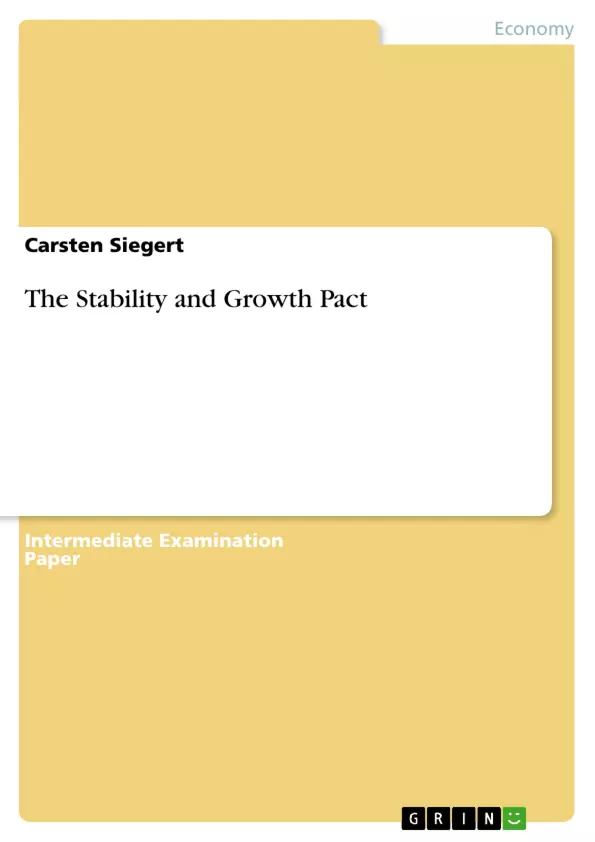In December 1991 at a summit in Maastricht the twelve nations, which
constituted the European Community at that time, agreed on a treaty to
transform the European Community into an European Union (EU). This Treaty
was signed 1992 and came effective on November 1st of 1993 as an
amendment to the treaty of Rome, the treaty the European Community
was build on. Four years later the treaty of Amsterdam put the treaty of Maastricht into
more concrete terms. The contracting parties agreed in Article B of this
treaty that the Union will set itself (among others) the objective to promote
economic and social progress through the establishment of an economicand
monetary union (EMU), ultimately including a single currency. Under
title V and VI of this treaty the countries also agreed to build up common,
foreign- and security policies as well as to intensify their cooperation in
fields of justice und home affairs. Title VII defines the ideas of a common
economic and monetary policy. The treaty of Amsterdam was signed on
October, 2nd 1997. Since all the Member States had to ratify the treaty by
their respective legislative procedures, it did not come into effect until the
end of May 1999.
The European treaties, taken together, form the primary legislation and
have characteristics of a constitution of the Community. The treaties
provide the legal basis for all secondary legislation, i.e. regulations,
directives and decisions of the institutions of the Community.
1 Peichl, Andreas (2003), p. 1-3.
2 Cowgill, Anthony and Andrew (2003b), p. 2.
Inhaltsverzeichnis (Table of Contents)
- Introduction - European Monetary Union: from the Treaty of Maastricht to the Stability and Growth Pact
- The Treaty of Maastricht
- The Treaty of Amsterdam
- Three Steps to the formation of an European Monetary Union
- Criteria of Stability and Convergence - Selection of Member States for the Single Currency
- From the criteria of stability and convergence to the Stability and Growth Pact
- Legal framework of the Stability and Growth Pact
- New monetarism - The Economic background of the Stability and Growth Pact
- Essential features of new monetarism
- Irrational decision making
- Debts as an expression of mislead fiscal policy
- Inflation
- The future role of fiscal policy
- Mechanics of the stability and growth pact
- The budgetary rules of the Treaty of Amsterdam as basic principles for the SGP
- The budgetary rules of the SGP
- The government budget deficit rule
- The medium-term balance rule
- Why 60% and 3%?
- The implementation of the Stability and Growth Pact
- "Stability" Committee
- Formulation of national stability and convergence programs.
- Enforcing the SPG - The excessive deficit procedure
- Early warning system to avoid excessive deficits
- Penalties for Breach of Stability Pact Criteria
- Assessment of the SGP - a look on the relevant indicators of the membership states of EU, Germany and of those countries joining the EU on May, 1st 2004
- Development within the EU
- Development in Germany
- Development in the "acceding countries"
- Conclusion
Zielsetzung und Themenschwerpunkte (Objectives and Key Themes)
This assignment analyzes the Stability and Growth Pact, a key component of the European Monetary Union (EMU). It explores the pact's historical development, economic rationale, and practical implementation. The assignment delves into the pact's legal framework, budgetary rules, and enforcement mechanisms. It also assesses the pact's effectiveness in promoting stability and convergence within the EU.
- The historical development and rationale behind the Stability and Growth Pact
- The economic foundations of the pact, particularly the principles of new monetarism
- The detailed mechanics and implementation of the pact's budgetary rules and enforcement procedures
- An assessment of the pact's impact on the EU, Germany, and countries joining the EU in 2004
- The effectiveness of the pact in achieving its objectives of stability and convergence
Zusammenfassung der Kapitel (Chapter Summaries)
The introduction traces the evolution of the European Monetary Union, from the Treaty of Maastricht to the Stability and Growth Pact. It examines the key milestones and agreements leading to the establishment of the EMU, including the role of the Treaty of Amsterdam in solidifying the pact's legal framework.
Chapter 2 delves into the economic underpinnings of the Stability and Growth Pact, focusing on the principles of new monetarism. It highlights the theory of irrational decision making, the importance of sound fiscal policy, and the potential risks of inflation. This chapter provides a theoretical context for understanding the pact's rationale.
Chapter 3 focuses on the mechanics of the Stability and Growth Pact. It outlines the pact's budgetary rules, including the government budget deficit rule, the medium-term balance rule, and the rationale behind the 60% and 3% thresholds. The chapter also discusses the pact's implementation mechanisms, including the role of the "Stability" Committee and the formulation of national stability and convergence programs.
Chapter 4 provides an assessment of the SGP by examining key indicators for EU member states, Germany, and countries joining the EU in 2004. It analyzes the economic performance of these countries in relation to the pact's criteria and objectives.
Schlüsselwörter (Keywords)
Key terms and concepts central to this assignment include European Monetary Union (EMU), Stability and Growth Pact (SGP), Treaty of Maastricht, Treaty of Amsterdam, new monetarism, fiscal policy, inflation, budgetary rules, deficit rule, medium-term balance rule, enforcement mechanisms, convergence criteria, economic performance, and accession countries.
- Citation du texte
- Dr. Carsten Siegert (Auteur), 2004, The Stability and Growth Pact, Munich, GRIN Verlag, https://www.grin.com/document/25265



